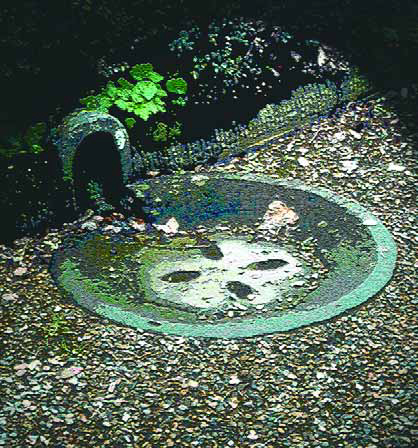The late, great architect John Lautner is believed to have been among the first to conceive of and build a vanishing-edge swimming pool as a means of more directly tying views across the water into distant vistas. It's a landmark of modern aquatic design that has been emulated thousands of times in the 45 years since he designed "Silvertop" in Los Angeles, and it's wonderful to know that his spirit of innovation survives to this day in the company he started. The home and watershapes seen here are the work of Lautner's protégé and longtime collaborator, Helena Arahuete of John Lautner Associates (Hollywood, Calif.), who composed it all as a spectacular exploration of organic design principles and the use of water to express and magnify details of a setting while leading the
When I first walked the four acres of wooded ravines of what would later be christened "The Garden of Wind and Pine" at the heart of the Garvan Woodland Gardens in Hot Springs, Ark., I was both delighted and daunted by the experience. The delight came in the site's sublime natural beauty, which reminded me of tromping through the woods as a child - an activity I enjoy to this day. As for my sense of unease, I don't know which was more significant: the expansiveness of the dry drainage ravines that were to be converted to ever-varying cascades and streams, or the omnipresence of ticks and poison ivy. When I made my first visit in the fall of 1999, the site was part of an undeveloped 210-acre woodland parcel on the shore of Lake Hamilton given to the Department of Landscape Architecture at the University of Arkansas in Fayetteville by Verna Garvan. She had long seen the peninsula as the ideal setting for a botanical garden and had spent two decades developing her vision, planting camellias and azaleas and a rose garden and commissioning a pavilion by the architect Fay Jones and his partner, Maurice Jennings. I had worked in Fayetteville before, crafting a
June 6, 1944, was a cold, dark, cloudy day along the northern coast of France. When the Higgins boats carrying allied troops slapped their gangways into the cold sea 60 years ago this month and released their human cargo onto the beach, withering machine gun fire greeted the soldiers from German bunkers high above the beach. Before the day was over, 6,603 Americans had lost their lives in what became known as D-Day - the start of the allied invasion of Nazi-occupied Europe. When planning started for a National D-Day Memorial to be built in Bedford, Va., the project's
Experts in watergardening and pond enthusiasts of all stripes are quite quick to claim that their form of watershaping is the fastest-growing segment of the industry and trumpet a history that stretches, they say, to the Islamic world, Japan and Europe. I can't say whether they're right or wrong with their assertions, but it's my sense as someone who's been designing with water for many years that the current trend toward naturalistic ponds and streams is quite strong (and probably getting stronger) and that it's important for all of us professionals to approach the art and science of "living" watershapes in a deliberate and thoughtful way. To that end, I've examined many publications dedicated to watergardening - and I'd be lying if I said that I've been
Some people seem to believe that designing is all about reinventing the wheel every time they go to work on a new project or need to create a new detail of some kind. Truth is, however, that most great design ideas and details are derivative of things that have been done before. This is why I'm such a strong advocate for education - especially the sort that involves venturing out into the world and seeing things with your own eyes. You can see pictures of things in books and watch slide shows in classrooms, and that's extremely valuable for the way it opens your eyes to
I never really thought much about the plants and trees surrounding me until I started edging my way toward the landscape-design business. Growing up, I'd look out my bedroom window and into our backyard and see plants and trees, but I didn't know that they were called Junipers or Giant Birds of Paradise or Ficus trees. They all looked pretty much the same to me - a generic veil of greenery. My path of discovery began when I bought my first house on Long Island. All of a sudden, there were rules about
We've all heard the phrase "less is more" so often that it's become a cliché, but there are still situations where there is powerful truth in those words. There is no question, for example, that watershapers can create tremendous beauty by using simple shapes and quality materials to accentuate and magnify a setting. This is particularly so when the watershaper exploits the alluring, reflective qualities of water itself to create a strong focal point while effectively blending the vessel into its setting. A case in point is the
When I was a kid, I was obsessed with hot rods. I suspect this resulted from my dad's subscriptions to magazines such as Road & Track and Street Rod: I was mesmerized by
It's a setting of searing beauty and now features a home that is unquestionably a work of art. Designed by renowned architect Helena Arahuete of Lautner & Associates (Hollywood, Calif.), the structure sits on a privately owned, 2,000-foot-tall mountain known as Twin Sisters Peak - just part of an 1,800-acre estate in Solano County, Calif., that offers clear vistas of the Pacific Ocean, Golden Gate Bridge, San Francisco Bay, the Sacramento Valley, Napa Valley and the Sierra Madre Mountains as you turn around the compass. In the great tradition of "organic architects" from Frank Lloyd Wright through to Arahuete's mentor and long-time collaborator, the late John Lautner, the home takes full advantage of its setting, crowning the mountaintop with a glass-and-concrete hexagon that at once beautifies and harmonizes with the landscape. So fascinating is this structure and so prominent is its location that, during construction and ever since, private
It's a setting of searing beauty and now features a home that is unquestionably a work of art. Designed by renowned architect Helena Arahuete of Lautner & Associates (Hollywood, Calif.), the structure sits on a privately owned, 2,000-foot-tall mountain known as Twin Sisters Peak - just part of an 1,800-acre estate in Solano County, Calif., that offers clear vistas of the Pacific Ocean, Golden Gate Bridge, San Francisco Bay, the Sacramento Valley, Napa Valley and the Sierra Madre Mountains as you turn around the compass. In the great tradition of "organic architects" from Frank Lloyd Wright through to Arahuete's mentor and long-time collaborator, the late John Lautner, the home takes full advantage of its setting, crowning the mountaintop with a glass-and-concrete hexagon that at once beautifies and harmonizes with the landscape. So fascinating is this structure and so prominent is its location that, during construction and ever since, private





















